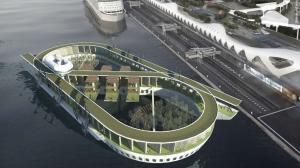Hong Kong entrepreneurs are seeking to invest HK$500 million in turning a cruise ship into the world’s first seaborne columbarium.
The floating columbarium is expected to provide about 48,000 funerary urn spaces, according to H.K. Ship Art Club, the main investor in the project. The boat riding club said people could purchase a space to store the cremated remains of their ancestors on the boat for upwards of HK$60,000.
Philip Li Koi-hop, the president of the club, said it was innovative idea to tackle the critical shortage of urn spaces in Hong Kong.

“In 20 years, Hong Kong will have to accommodate 288,000 dead people,” Li said. “Now we see people storing their ancestors’ ashes in private buildings for excessive amount of money.”
“If people are worried their rights to their land might change after 2047, they should start thinking about storing their ancestors’ ashes in a boat.”
The Food and Environmental Hygiene Department said the city would see a shortage of 400,000 niches by 2023. There are now about 50,000 deaths in Hong Kong each year.
The former CEO of the now defunct Hong Kong North West Express revealed his new business venture on Thursday. He said his partners were still deciding on the right ship to purchase from three potential candidates, which is expected to cost about HK$140 million.
“It will be a ship that is about 60,000 tonne,” he said, adding the ship would have the capacity to accommodate about 1,000 visitors. There would be religious personnel from all major religions to perform services and rituals for visitors. However, the burning of incense and paper would not be permitted in the cabinet due to safety reasons.
Li said the ship would mostly be stationed in the city, in Kowloon Bay near the Kai Tak Cruise Terminal.
“We would arrange little boats to transfer people from the pier to the columbarium,” Li said.
During festivals such as the Tomb-Sweeping Day or the Double Ninth Festival when business will be in full swing, each visitor will only be allowed three hours on the ship.
While stationed, Li said tours of the ship would also be provided to the public as well as a museum in which classes in theology and philosophy would be provided.
John Tam Man-tat, the director of maritime operations for the club, said the ship would be mobile during other times.
“It would be a fully functional cruise ship in which there would be restaurants, gym rooms, hotel rooms and a movie theatre,” Tam said.
He said they planned to launch the business three months after purchasing the ship, and after the Marine Department examines and audits the ship and approves the project.
The Marine Department said they had yet to receive all the details about the project.
But the department said that if the ship is registered as a Hong Kong local vessel, it has to comply with the Merchant Shipping (Local Vessels) Ordinance. Otherwise, it needs to act in accordance with the international maritime labour convention and relevant local ordinances.
Tam said they had not yet decided whether they would register their vessel as a local one or a Panamanian one, which would free them from many Hong Kong marine regulations.
Soon after the announcement, local architecture firm Bread Studio, which proposed a similar idea several years ago, expressed interest in the project.
Paul Mui, design director at Bread Studio, said he had approached Li about the project, and they had agreed to meet in the next few days.
“Our plans for the floating cemetery seem to be very similar in many aspects, so we are meeting to see if there’s any common ground on which we can work together.”
In 2012, Bread Studio proposed the idea of turning an ocean liner into a seafaring cemetery to alleviate the growing shortage of burial space. The project, which they called the “Floating Eternity”, was said to have the capacity to house the ashes of 370,000 people.

Mui said he was currently in talks with some mainland investors about the Floating Eternity, but the discussion was still at a very early stage.
He said he was approached by some US investors in 2012, but they never got back to Bread Studio after receiving detailed information about the project. The proposal, first published in The Hong Kong Institute of Architects Journal, has not attracted any interest from the government.
According to Mui, building and managing a floating cemetery is a practical business venture. With a gross columbarium space of 370,000 and a HK$5,000 price for each space, the first phase of the Floating Eternity project could bring in HK$ 18.5 billion for a full house.
The vessel was designed to be about the size of a Panamax (the limit for ships travelling through the Panama Canal), with four principal floors. The construction cost of the Floating Eternity was roughly estimated to be about HK$270 million in 2012.










